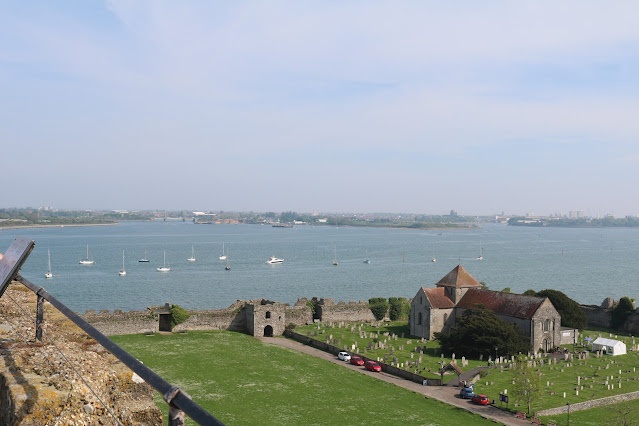In early May, we went away for a weekend. We had booked a hotel in Portsmouth and planned to visit the historic dockyard and also to take in the Royal Armouries at Fort Nelson. Fort Nelson was built in the 1860's to protect Britain from an expected invasion from France. It gave fire power to stop the enemy capturing Portsmouth naval dockyard. The war never came but Fort Nelson did play its part in World War 1 and in world war 2 helped to prevent another possible invasion from the Germans. The fort itself is very well preserved and there was a lot to explore including the barracks, guardroom and tunnels. Fort Nelson now houses the artillery collection of the Royal Armouries which is the national museum of arms and armour. Fort Nelson is just one of the three sites that house the collection.
The fort is a very complex building on several levels with outer walls of irregular lengths and an interesting range of heights and angles. I got a little confused as we went through the galleries due to the angles. In order to house the museum there have been some changes to the galleries, not least the nice glass entrance.
The shape and design of the fort make it able to protect against attack from the sea and also the land around it. It had a range of guns to provide long, medium and short range fire. The galleries in the main building were interesting with a wide range of artillery not just British but also from other countries and from different eras in history.
I was interested in the 'Smith' gun. This was used by the Home Guard but also by the regular army.
The wheels allowed the gun to be transported to where it was needed and then the operator would flip it onto its side so it sat on the lower wheel and the upper wheel potentially provided some shade for aiming the gun.
We walked through the tunnel to the ramparts. The old conveyer belt along the wall was used to move the shells to the guns.
There were areas off the tunnels where the magazine was situated for storing the powder barrels. The tunnel was cold and damp and I was pleased to be out in the fresh air again.
It was also fun spotting the graffiti. Never let it be considered a new activity.
There was so much to see and the best of all there was no entry charge to the museum. The day was very hot and sunny and we finished our visit in the cafe to rehydrate ourselves.
Having seen all we wanted to see we headed for Portchester castle. The castle is set within the preserved walls of a Roman fort and sits on a tongue of land that projects into the natural harbour of Portsmouth. There is a lot of history happening here. The guide book tells me that the Roman fort was probably established in AD 280's. There was a Saxon community here in about AD 904 and it became a stronghold to protect the kingdom of Wessex. Following the Norman Conquest in 1066 the Roman fort walls provided a defensive perimeter to a large castle. A monastic foundation was established around 1128 and the parish church remains today within the outer walls. The 12th century keep has survived and we climbed to the top.
The keep stands at 100 feet and there were quite a lot of old worn stone spiral steps to reach the top. There were also some newer wooden steps to several floors. The view from the top was worth the climb
On one of the floors there was this sculpture. In 1796 more than 2000 prisoners of war arrived at Portchester Castle from the Caribbean having been captured following fighting between Britain and France. Amongst the captured were 99 women and children. Some prisoners were released but many were kept at Portchester until the weather became too cold in the castle. The women and children were sent to Forton Prison where they lived in a hospital ward. Eventually the prisoners were exchanged for British soldiers and sent to France
There were also two old wall paintings. I couldn't fully make out what they were, maybe you can,
To finish our visit we walked round the outer walls before returning to the car and enjoying a cooling ice cream. Several plants have made the walls their home.
A great day out. We were both rather warm and tired as we headed to our hotel and dinner. I'll tell you about our trip to the Historic dockyard tomorrow.
Take care
Lyndsey





















No comments:
Post a Comment